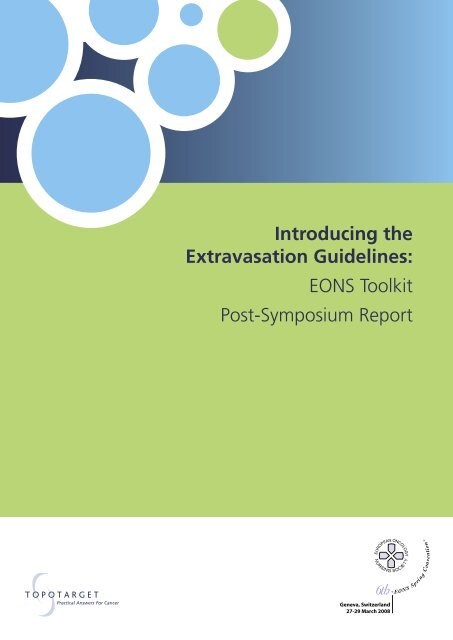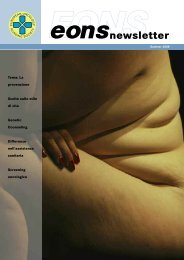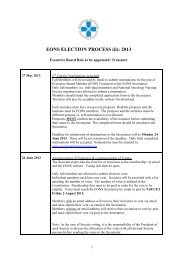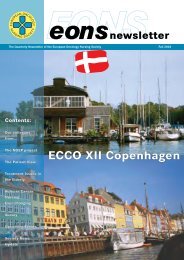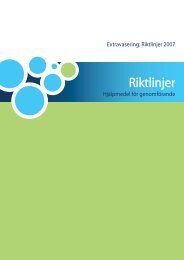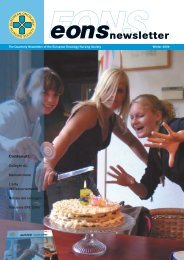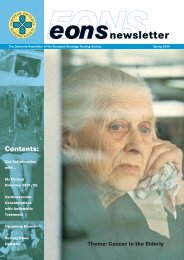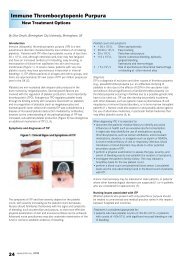Introducing the Extravasation Guidelines - the European Oncology ...
Introducing the Extravasation Guidelines - the European Oncology ...
Introducing the Extravasation Guidelines - the European Oncology ...
Create successful ePaper yourself
Turn your PDF publications into a flip-book with our unique Google optimized e-Paper software.
<strong>Introducing</strong> <strong>the</strong><br />
<strong>Extravasation</strong> <strong>Guidelines</strong>:<br />
EONS Toolkit<br />
Post-Symposium Report
<strong>Introducing</strong> <strong>the</strong> <strong>Extravasation</strong> <strong>Guidelines</strong><br />
YVONNE WENGSTRÖM<br />
New extravasation guidelines to provide advice to health care professionals on how to manage<br />
extravasation were recently launched at <strong>the</strong> 6th <strong>European</strong> <strong>Oncology</strong> Nurses Society (EONS) Spring<br />
Convention held in Geneva, Switzerland.<br />
As EONS Past President, I was delighted<br />
to be part of <strong>the</strong> team involved in<br />
developing <strong>the</strong> new guidelines, and to<br />
chair <strong>the</strong> satellite symposium where <strong>the</strong>y<br />
were officially launched. Developing<br />
and using guidelines are an extremely<br />
important part of providing <strong>the</strong> highest<br />
quality care to our patients. Through<br />
<strong>the</strong> process of development, involving<br />
<strong>the</strong> critical analysis of local protocols<br />
and policies, care pathways and quality<br />
evaluation, we can see why.<br />
EONS convened a committee of<br />
independent nurses to develop a set of<br />
recommendations to assist <strong>the</strong> health<br />
care team in preventing, diagnosing<br />
and treating extravasations. Using <strong>the</strong>ir<br />
collective experience of developing and<br />
implementing guidelines, alongside<br />
expertise in initiating change, <strong>the</strong> aim was<br />
to provide guidance for use in routine<br />
practice and improve patient care.<br />
Who has been involved The <strong>Guidelines</strong> Committee<br />
Yvonne Wengström<br />
Immediate Past<br />
President of EONS<br />
and Professor of<br />
Cancer Care<br />
Jan Foubert<br />
Senior Lecturer<br />
in Nursing and<br />
Midwifery, Executive<br />
Director of EONS<br />
Anita Margulies<br />
Clinical Nurse and<br />
Lecturer, Board<br />
member of EONS and<br />
<strong>the</strong> Swiss <strong>Oncology</strong><br />
Nursing Society<br />
Helen Roe<br />
Consultant Cancer<br />
Nurse / Lead<br />
Chemo<strong>the</strong>rapy<br />
Nurse, Board member<br />
of UKONS<br />
Sebastien Bugeia<br />
<strong>Oncology</strong> Nurse,<br />
Board member of<br />
<strong>the</strong> French <strong>Oncology</strong><br />
Nursing Society
INTRODUCING THE EXTRAVASATION GUIDELINES:<br />
EONS TOOLKIT POST-SYMPOSIUM REPORT<br />
<strong>Extravasation</strong>s: a shared responsibility between <strong>the</strong><br />
specialist nurse and oncologist - Facts and figures<br />
about extravasations<br />
A N I TA M A RGULIES<br />
With over one million intravenous chemo<strong>the</strong>rapy infusions and injections given worldwide everyday,<br />
health care professionals endeavour to minimise adverse events and complications for patients.<br />
Nurses routinely administer intravenous<br />
cancer drugs and are closely involved<br />
in providing patients with information<br />
about medications and potential<br />
side effects. As well as this, <strong>the</strong>ir<br />
close involvement in administering<br />
chemo<strong>the</strong>rapy means <strong>the</strong>y are better<br />
skilled in phlebotomy techniques<br />
and proper cannulation. Playing this<br />
pivotal role in <strong>the</strong> administration of<br />
chemo<strong>the</strong>rapy means that nurses are<br />
often better skilled in being able to<br />
prevent, recognise and manage an<br />
extravasation if it should occur.<br />
Forming a treatment consensus within<br />
health care teams is vital and can be<br />
done by sharing knowledge and<br />
defining roles and responsibilities<br />
as a group, which will in turn avoid<br />
conflicting interventions and secure<br />
quality assurance.<br />
The role of <strong>the</strong> health care team is<br />
to decide what immediate measures<br />
should be taken when an extravasation<br />
occurs and to inform <strong>the</strong> health care<br />
team of <strong>the</strong> subsequent treatment<br />
strategies. Ongoing team meetings<br />
provide an ideal forum to discuss cases,<br />
share experiences and develop standard<br />
operating procedures which can <strong>the</strong>n<br />
be implemented when educating health<br />
care teams involved in <strong>the</strong> administration<br />
of parenteral cancer drugs.<br />
Therefore, it is even more important<br />
to recognise that <strong>the</strong> new guidelines<br />
currently provide <strong>the</strong> best source of<br />
information for professionals. It is<br />
anticipated that <strong>the</strong>se guidelines will<br />
encourage adoption of recommended<br />
procedures and <strong>the</strong> successful<br />
management of extravasation which<br />
will provide <strong>the</strong> patient with <strong>the</strong> safety<br />
<strong>the</strong>y deserve.<br />
In conclusion, <strong>the</strong><br />
cancer care team face<br />
numerous challenges<br />
with respect to <strong>the</strong><br />
parenteral<br />
administration of<br />
cancer drugs
Sharing and implementing best practice<br />
– Content of <strong>the</strong> guidelines<br />
Y VONNE WENGSTRÖM<br />
The overall goal of <strong>the</strong> new guidelines is to help nurses understand and recognise extravasation,<br />
as well as improve <strong>the</strong> prevention and overall management of extravasations in cancer patients.<br />
Alongside <strong>the</strong>se overall goals <strong>the</strong>re are a number of fur<strong>the</strong>r targets and aims linked to specific elements of extravasations, such as:<br />
• Causes and risk factors<br />
• Features and symptoms<br />
• Differences versus flare and o<strong>the</strong>r reactions<br />
• Implications of extravasation if left untreated<br />
• Prevention measures<br />
• T he use of antidotes to counteract extravasation<br />
• The nurses’ role in extravasations<br />
Intervention (strategy)<br />
Knowledge<br />
Innovations<br />
<strong>Guidelines</strong><br />
Staff (training,<br />
attitudes)<br />
Contextual factors<br />
Culture, climate<br />
Leadership<br />
Change of practice<br />
Changed behavior<br />
Improved patient<br />
outcomes<br />
Status quo!!<br />
Organization<br />
Resources<br />
To explore some of <strong>the</strong> key elements of successful implementation in more detail, <strong>the</strong> PARIHS (Promoting Action on Research<br />
Implementation in Health Systems) model is especially relevant. For example, evidence should be well conducted and have a<br />
consensus about it and should include clinical experience verified through reflection, critique and debate.<br />
Health care teams play a key role in implementation of guidelines.
INTRODUCING THE EXTRAVASATION GUIDELINES:<br />
EONS TOOLKIT POST-SYMPOSIUM REPORT<br />
The importance of using guidelines in clinical practice<br />
– Case study of anthracycline extravasations<br />
H E L EN ROE<br />
Some professionals may consider anthracycline extravasations to be a rare but unfortunate<br />
consequence of administering chemo<strong>the</strong>rapy, so why are guidelines so important<br />
<strong>Guidelines</strong> are essential to ensure<br />
safe practice, provide evidence based<br />
care and increase awareness amongst<br />
professionals enabling <strong>the</strong>m to share<br />
experiences. Until recently, <strong>the</strong>re has not<br />
been any licensed treatment for dealing<br />
with anthracycline extravasations and<br />
teams have used a number of different<br />
non evidence based approaches.<br />
Managing extravasations<br />
Patient details: 47 year old woman with grade 3 breast tumour, had a mastectomy and axillary sampling, and was recommended<br />
to receive FEC100 (5-fluorouracil, Epirubicin and Cyclophosphamide). The anthracycline extravasation happened after cycle 4. The<br />
patient complained of some pain during <strong>the</strong> infusion and <strong>the</strong> nurse noticed a swelling near <strong>the</strong> cannula site. Initial management of<br />
<strong>the</strong> extravasation was performed locally and <strong>the</strong>n <strong>the</strong> patient was referred to <strong>the</strong> regional Plastics Centre where <strong>the</strong> area was ‘flushed’.<br />
Consequences of treatment:<br />
• Patient had to travel to regional plastics centre for surgery<br />
• Invasive treatment<br />
• Painful for <strong>the</strong> patient<br />
• Increase risk of infection for chemo<strong>the</strong>rapy treated patients<br />
• Delay in receiving next cycle of chemo<strong>the</strong>rapy<br />
• Ongoing care needed<br />
Two years on:<br />
• Patient requires antibiotics post procedure<br />
• <strong>Extravasation</strong> area remains visible<br />
• Restricted hand movement<br />
• Skin remains ‘tight’<br />
• Periodically experiences pain in <strong>the</strong> area<br />
• Flare-ups occur<br />
• Permanent reminder
Savene ® : <strong>the</strong> only licensed antidote for<br />
anthracycline extravasation<br />
More recently, a new treatment option specifically licensed for treating anthracycline extravasations<br />
has become available - <strong>the</strong> antidote Savene ® . Clinical experience of <strong>the</strong> use of Savene ® is described<br />
in <strong>the</strong> case study below:<br />
Patient details: 29 year old woman, diagnosis of breast cancer, receiving Epirubicin. <strong>Extravasation</strong> occurred after cycle 5, with<br />
initial symptoms being swelling and redness.<br />
Procedure:<br />
• Infusion stopped and hospital extravasation guidelines followed<br />
• <strong>Extravasation</strong> managed with Savene ®<br />
• S avene ® administered once daily for three consecutive days<br />
(according to product licence)<br />
Post treatment:<br />
• 24 hours after treatment with Savene ® symptoms<br />
were relieved<br />
– Symptoms did not reoccur<br />
– Patient could continue scheduled chemo<strong>the</strong>rapy without delay<br />
These case studies help to demonstrate that <strong>the</strong>re are several important factors required in order to improve clinical practice, and<br />
ultimately <strong>the</strong> patient experience, including:<br />
• Increasing awareness of extravasations amongst professionals<br />
• Creating a standardised management pathway<br />
• Clear guidance on <strong>the</strong> use of antidotes<br />
• National (or <strong>European</strong>) audit
INTRODUCING THE EXTRAVASATION GUIDELINES:<br />
EONS TOOLKIT POST-SYMPOSIUM REPORT<br />
Anthracycline extravasations – doing <strong>the</strong> right thing<br />
D R JAN BUTER<br />
Anthracyclines are widely used in oncology treatment and indicated in areas including cancers of<br />
<strong>the</strong> blood (e.g. leukaemia), Hodgkin’s disease, non-Hodgkin’s lymphoma, small cell lung cancer and<br />
cancers of <strong>the</strong> breast, ovaries, stomach, bladder and bone. Anthracyclines are used as adjuvant,<br />
neo-adjuvant or palliative treatment and are usually scheduled every three to four weeks.<br />
When an anthracycline extravasation<br />
occurs it can cause a number of symptoms,<br />
including pain, redness, swelling, infusion<br />
stop, blistering, ulceration and necrosis.<br />
Fur<strong>the</strong>rmore it can cause interruption and<br />
delay of primary chemo<strong>the</strong>rapy treatment.<br />
The emotional stress experienced by <strong>the</strong><br />
patient is also an important consequence<br />
of an extravasation and should not be<br />
forgotten.<br />
The optimal treatment of anthracycline<br />
extravasation has previously been<br />
controversial, with experimental<br />
Mean wound area<br />
(mm2)<br />
30<br />
25<br />
20<br />
15<br />
10<br />
5<br />
methods including cooling/heating,<br />
flushing and topical DMSO. Two recent<br />
multi-centre studies which investigated<br />
Savene ® found it to be an effective acute<br />
treatment, which was well-tolerated in<br />
<strong>the</strong> patient population and worked in<br />
extravasations from both a peripheral<br />
line and central venous access.<br />
Savene ® has since become <strong>the</strong> only<br />
licensed treatment for anthracycline<br />
extravasation. Fur<strong>the</strong>r evidence to<br />
support <strong>the</strong> efficacy of Savene ® is<br />
highlighted below:<br />
Savene ® prevents damage<br />
No Savene ®<br />
p < 0.0001<br />
Savene ® 250 mg/kg IP<br />
0<br />
0 10 20 30 40<br />
Days<br />
Reduction of Doxorubicin induced skin<br />
ulcers in mice<br />
One IV injection of Savene ® significantly<br />
reduces wound size<br />
Ref: Langer SW, Sehested M, Jensen PB. Treatment of anthracycline<br />
extravasation with dexrazoxane. Clin Cancer Res. 2000b;6:3680-6<br />
Mean wound area vs time of individual mice after 2 or 3 mg/kg doxorubicin SC followed by saline IP (n = 56) or<br />
Savene® 250 mg/kg IP at t=0 (n= 55).<br />
Patient #1<br />
• <strong>Extravasation</strong> of 149 mg of doxorubicin<br />
• Port-a-Cath<br />
• Angiografi, UL<br />
• Savene ® in a three day schedule<br />
• Indurations, dry skin after one week<br />
Photos: G. Giaccone 2000<br />
Day 7 Day 48<br />
The new guidelines are extremely useful<br />
to <strong>the</strong> health care professional thanks<br />
to <strong>the</strong>ir accessibility. They also highlight<br />
<strong>the</strong> importance of administration of<br />
extravasation antidotes by correctly<br />
trained personnel, with treatment<br />
according to <strong>the</strong> specific drug.<br />
My call to action to colleagues would be<br />
<strong>the</strong> following:<br />
• Be vigilant<br />
• Be honest<br />
• Be prepared and informed<br />
• Be proactive<br />
As such, <strong>the</strong> guidelines are <strong>the</strong> ideal tool<br />
to use to practice <strong>the</strong>se actions, <strong>the</strong>reby<br />
managing an extravasation effectively<br />
and in <strong>the</strong> optimum way for both patient<br />
and health care professional.
Conclusions<br />
YVONNE WENGSTRÖM<br />
From <strong>the</strong> launch of <strong>the</strong> guidelines at EONS Spring Convention 2008, <strong>the</strong>re are five major<br />
conclusions which <strong>the</strong> panel agreed should be <strong>the</strong> key points for using <strong>the</strong> guidelines and<br />
managing an extravasation:<br />
• N urses play a pivotal role in <strong>the</strong><br />
management of chemo<strong>the</strong>rapy<br />
and should be prepared and<br />
informed about <strong>the</strong> possibility of<br />
extravasations occurring<br />
• O ptimising patient comfort, safety<br />
and care should be <strong>the</strong> aim of all<br />
nurses involved in oncology<br />
• S haring responsibilities within teams<br />
is essential – it allows problems to<br />
be shared, quality assured and best<br />
practice to be followed<br />
• G uidelines are a vital tool for <strong>the</strong><br />
purpose of preventing and managing<br />
extravasations<br />
• T he antidote to treat anthracycline<br />
extravasations should be:<br />
– evidence based<br />
– supported by clinical trial data<br />
– proven<br />
– available in clinical practice<br />
The guidelines committee welcome<br />
comments and feedback. For details<br />
of how to submit <strong>the</strong>se, contact details<br />
are provided below. We look forward<br />
to hearing from you.<br />
To obtain a copy of <strong>the</strong> <strong>Guidelines</strong> please visit:<br />
http://www.cancerworld.org/CancerWorld/getStaticModFile.aspxid=1987<br />
For fur<strong>the</strong>r information please contact:<br />
Yvonne Wengström<br />
Professor of Cancer Care<br />
Deputy Director Research and Development Cancer Care<br />
Research Centre Unit 1<br />
Scion House<br />
University of Stirling<br />
Stirling<br />
FK9 4NF<br />
Tel: +44 1786 460062<br />
Fax: +44 1786 460060<br />
Email: yvonne.wengstrom@stir.ac.uk<br />
References<br />
i E uropean <strong>Oncology</strong> Nurses Society http://www.cancerworld.org/CancerWorld/moduleStaticPage.aspxid=3891&id_sito=2&id_stato=1 [accessed March 2008]


